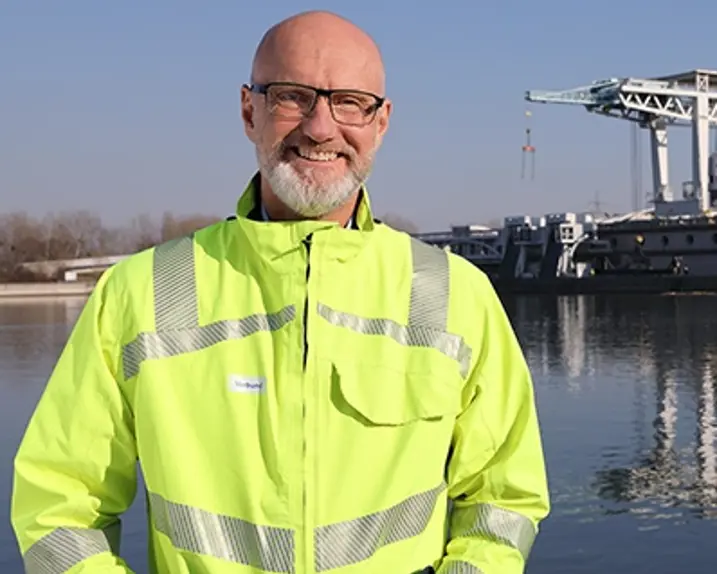Bank restoration at the mouth of the Mattig river promotes species conservation on the Inn
VERBUND regularly emphasises the importance of sustainable electricity generation from hydropower for achieving the climate and energy targets. Appropriate measures ensure that ecology and electricity generation are coordinated even better with each other. The Inn bank in the area of the Mattig estuary is now being dismantled as a contribution to the INTERREG project “INNsieme”.
In the INTERREG project “INNsieme”, in which VERBUND is committed to a living Inn together with the lead partner WWF Austria, VERBUND is dismantling the banks of the Mattig estuary. Over a total distance of 569 metres between Inn river kilometres 56.26 and 55.59, the bank is being dismantled through the removal of the stone blocks. Low-lying banks, small bays as well as structures made from dead wood and stones are intended to make the bank area more friendly to life, both on land and in the water. “On a river that has been reshaped by people for over 200 years, hydropower is the latest amongst the many usage interests on the Inn. At the same time, it is a pioneer in withdrawing measures – not only hydropower – and handing over more space to flora and fauna. That is why we are now implementing another step for improving habitat on the Inn in the area of the Mattig estuary and are committing ourselves to more sustainability in the INNTEREG project ‘INNsieme’,” says Michael Amerer, managing director of the border power plants, explaining the philosophy of VERBUND.
Special importance is therefore also being given to the estuary area by connecting the Mattig to the Inn to allow fish to pass along it, enabling them to evade and take shelter when water levels in the Inn are high. “Protecting and restoring species diversity on the Inn is a task of the century, which we are pursuing together in the INNsieme project. The dismantling of the bank in the area of the Mattig river is groundbreaking. It will return another piece of natural habitat to the Inn,” adds Gerhard Egger, head of water conservation at WWF Austria.
Coordinated procedure
The measure on the Inn in the area of the Mattig estuary is coordinated with further activities for improving the ecological conditions, which are being carried out under the LIFE project “LIFE Riverscape Lower Inn”. These include creating consistency and habitats at the Braunau-Simbach power plant, which are currently under approval. Overall, despite the many usage interests, a large number of measures aim at once again enabling the Inn to offer suitable habitats for species that are typical of this area, but whose existence is at risk. To this end, a species conservation action plan was created in the project “INNsieme” that for the first time presents a total overview of the possible courses of action.
More electricity from the Ering-Frauenstein power plant
At the same time as the ecological improvements at the Mattig estuary, the Ering-Frauenstein power plant is currently being revitalised. Since its initial operation in 1943, it has reliably generated clean electricity from the hydropower of the Inn. The “Consistency and Habitat” project implemented at the power plant is an example of the compatibility of hydropower and ecology on an Inn shaped by human hands in the past 200 years. Extensive maintenance work is now being carried out until 2024 on the 3 machine sets, large parts of which still date to the year 1943. Where possible, modern components will be used which should generally lead to an efficiency increase of the existing power plant. It is expected that these purely technical measures will enable the current annual electricity generation of around 434 million kilowatt hours to be increased by 10% without any additional resources. That corresponds to about the annual power consumption of 11,000 households. Most of the work will be done in the low water periods from September to April.
About INNsieme
The project was started in 2019. Within three years, a cross-border action plan for habitat and species protection on the Inn should be created so that the three-country river can fully develop its function as a lifeline for plants, animals and people again by 2030. To this end, an integrated vision will be developed for the Inn that defines an ideal condition in which the Inn is fully functional as a living ecosystem and the habitat conditions meets the specialised requirements of the resident species. Also associated with this is the definition of suitable recommendations for action that mitigate existing negative influences on the alpine river and improve living conditions for flora and fauna. In this way, the action plan should highlight which measures are to be implemented on which section of the Inn and for which purposes, and thus offers valuable guidance for the effective implementation of protective measures.
Project partners are WWF Austria, the province of Tyrol, the University of Innsbruck and VERBUND. The supporting or associated partners include the Bavarian State Ministry of the Environment and Consumer Protection, the province of Upper Austria (department for conservation and department for water resource planning).
